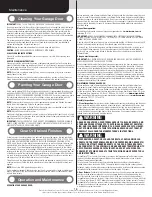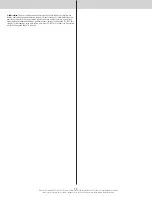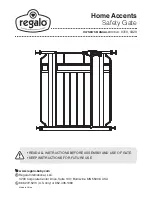
Cable drums RH/LH Torsion springs RH/LH
Cotter pin
(as required)
5/16” x 1-1/4”
Clevis pin (as required)
Center bearing bracket
assembly (as required)
Center bearing bracket
assembly (as required)
(2) Cable sheaves
Key shafts
(as required)
Hinges
Half Center
hinges (as required)
Strut clips
(as required)
Center coupler
assembly (as required)
Counterbalance
lift cables
Weather seals
& nails (If included)
Cable sheave
saddles (as required)
Oval Bearings
(as required)
(2) 3/8”-16 x 3/4”
Truss head bolts
1/4” - 14 x 1”
Lag screws (as required)
1/4”-20 x 9/16”
Track bolts (as required)
Pull down rope
(if included)
Lift handles
(as required)
Bottom weather seal with
3/4” nails (as required)
(2) 3/8”- 16 Hex nuts
5/16” x 2” Tamper-resistant hex head
lag screw (as required)
1/4”- 20 Flanged
hex nuts (as required)
5/16”-16 x 3/4” Square neck
carriage bolts (as required)
3/8” Washers
(as required)
5/16”-16 Hex
nut (as required)
3/8”-16 x 1-1/2” Hex bolts
1/4” - 10 x 1” Tamper-resistant
hex head lag screw (as required)
5/16” x 2” Hex head lag screws
(as required)
1/4” - 20 x 1 7/8”
Carriage bolts (as required)
5/16” x 1 5/8” Hex head lag screws
(as required)
1/4”-20 x 7/8” Self
drilling screws (as required)
Door Section Identification
When installing your door, you must use sections of the appropriate height in the right stacking
location. Determine, what sections you need to use in what order depends on the design of your
door.
Sections are stamped for identification, #1, #2, #3, #4, #5, #6, #7, and #8. The stamp, located
on each side of the sections identifies the stacking sequence. The sequence is always deter-
mined by #1 being the bottom section to #7 or #8 being the highest top section. If the stamp on
the section is illegible, refer to the section side view illustration. The section side view illustration
shows the section profile of all sections, and can also be used to identify each section.
The
BOTTOM SECTION
can be identified by #1.
The
INTERMEDIATE I
SECTION can be identified by #2.
The
INTERMEDIATE II
SECTION can be identified by #3, for a 4 section high door only.
The
INTERMEDIATE III
SECTION can be identified by #4, for a 5 section high door only.
The
INTERMEDIATE Iv
SECTION can be identified by #5, for a 6 section high door only.
The
INTERMEDIATE v
SECTION can be identified by #6, for a 7 section high door only.
The
TOP SECTION
can be identified by a #, being the highest section.
Bottom
rail
Bottom
rail
Top rail
Typical design option “Outside surface of
door sections shown”
Bottom
section
Intermediate(s)
Top
section
Side views of sections
Outside
surface
Inside
surface
1.
Bottom
section
2.
Intermediate I
section
3.
Intermediate II
section
4. or 3.
Top
section
#
#
1
Typical
stamping
location
NOTE:
3 Section high doors, does not have
an Intermediate II Section.
Graduated End Hinge And
Strut Identification
Graduated End Hinge Schedule
Door Height
Track
Section Type
Graduated End Hinge
Number
3 Section High Door
2”
Top
N/A
Intermediate I
#2
Bottom
#1
3”
Top
N/A
Intermediate I
#4
Bottom
#3
4 Section High Door
2”
Top
N/A
Intermediate II
3#
Intermediate I
2#
Bottom
1#
3”
Top
N/A
Intermediate II
5#
Intermediate I
4#
Bottom
3#
5 Section High Door
2”
Top
N/A
Intermediate III
4#
Intermediate II
3#
Intermediate I
2#
Bottom
1#
3”
Top
N/A
Intermediate III
6#
Intermediate II
5#
Intermediate I
4#
Bottom
3#
4
Please Do Not Return This Product To The Store. Contact your local Wayne-Dalton dealer. To find your local Wayne-Dalton dealer,
refer to your local yellow pages business listings or go to the Find a Dealer section online at www.Wayne-Dalton.com
Summary of Contents for 105/110
Page 21: ......





































